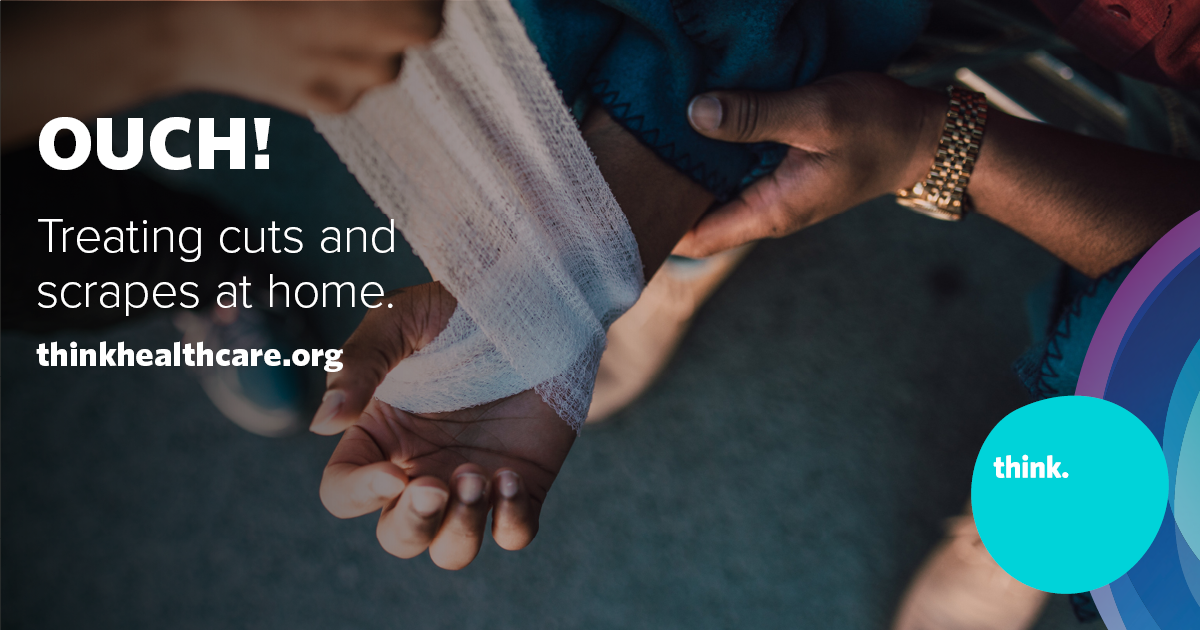Our bodies can take a beating. With everyday activities, it’s not uncommon to get a bump, bruise, scrape, or cut. You can usually treat minor medical conditions at home — without professional intervention.
How to treat your cuts and scrapes
The following outlines basic first aid steps to assessing and treating cuts and scrapes at home. As with any medical condition, trust your instincts. If you feel like you need professional assistance, don’t hesitate to reach out to an appropriate level of healthcare provider.
Assessing your wound.
Seek medical attention if your wound is more than a bump or scrape such as:
- Excessive bleeding
- Skin tear that exposes more than ¼ inch of an open wound
- Appears deep
- Has something lodged in the wound
- Is an injury to your head
- Accompanied by other symptoms such as dizziness, fever, fatigue, confusion
Cleaning the cut.
To avoid additional damage to your wound, follow this two-step process to clean your wound:
- Before you do anything, wash your hands with soap and water.
- Rinse the wound with tap water. You can wash it under a faucet or pour water over it. The object is to flush the wound of any debris. Don’t worry if it continues to bleed a little. Flowing blood will help facilitate the cleaning process. There is no need to apply Hydrogen Peroxide, antiseptic spray, alcohol, or other over-the-counter medications. These can lead to irritation and can impede the healing process.
Treating cuts and scrapes – control the bleeding.
As mentioned before, some bleeding is good for your wound as it will help facilitate the cleaning and healing process. To stop the bleeding, follow these steps:
- Find a clean piece of gauze, cloth, or paper towel.
- Apply light pressure to the wound using the material to absorb excess blood. Most minor wounds will stop independently, whereas cuts to the head or hands may take more time to clot.
- Don’t remove the cloth “to check on the clotting process.” Removing pressure can reopen the wound. After a few minutes, if you notice less blood absorbing into the cloth, you can check if the bleeding has stopped. Raising the wound above your heart can help slow down the flow of blood and help with coagulation.
Treating cuts and scrapes – Cover your wound.
- Select the appropriate bandage for your wound. If it’s small, you may opt not to cover it. We recommend always using a bandage for at least the first day or two. Your bandage should be large enough to span the wound and adhere to stable, healthy skin.
- Wrap the wound with sterile gauze and secure the bandage to itself with more gauze and medical tape.
- Do not tape your bandage to your skin if you have fragile skin and have experienced a skin tear.
- You can opt to apply a small amount of antibiotic ointment or cream.
- Change your bandage daily or sooner if they get dirty or wet.
- Most minor wounds will need five to seven days of coverage before they can be exposed.
Treating cuts and scrapes – Monitor your wound
When treating any wound, infection is always a possible threat. When you change your bandage, check your wound to see if the redness around the lesion is expanding. It’s normal to have a little redness around the edge of a wound. If you notice any of the following, contact your think nurse or doctor:
- Radiating warmth
- The red area is expanding
- Red streaks around the wound
- Persistent soreness or increasing pain
- Colored discharge like pus or drainage
Treating cuts and scrapes – About scabs
Part of the healing process for all wounds is the formation of scabs. Scabs are nature’s bandage. They are one of the best ways to help facilitate the healing process. During the healing process, scabs can get itchy and may be tempted to pick. Try to avoid succumbing to the temptation. Removing a scab before it’s ready to fall off can cause even more damage to the wound-oftentimes resulting in a scar or secondary infection.
If you happen to have a cut or scrape that you aren’t confident in taking care of, you can always visit thinkQuick Walk-in Clinic. Our providers will be happy to get you cleaned up, bandaged, and on your way in no time!
